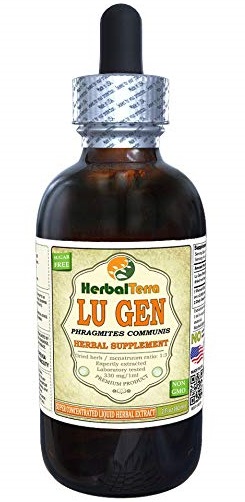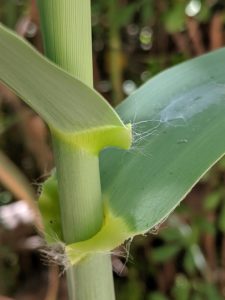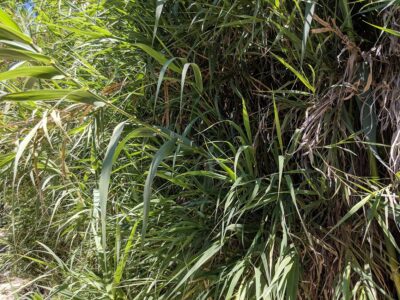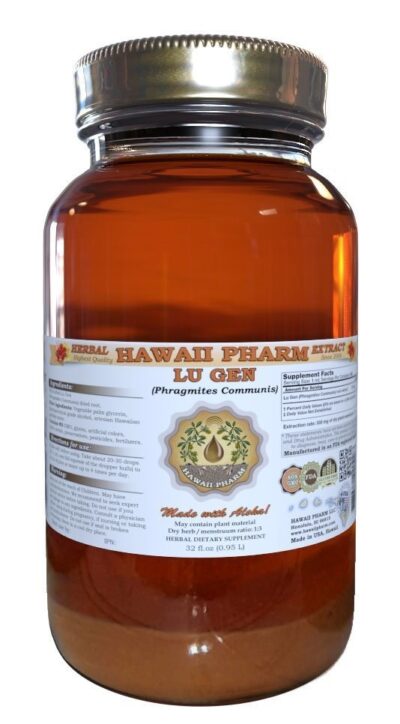The common reed (scientifically known as Phragmites) is a genus of four species of large aquatic grasses. The most prevalent of them is called Phragmites australis.
The common reed is also referred to in scientific papers as Arundo isiaca, Arundo phragmites, Arundo vulgaris, and Phragmites communis.
The common reed is a cosmopolitan plant, meaning it is found throughout the world. And since it is said to contain a number of psychoactive tryptamines, including N,N-DMT, this means that the common reed may be a source of DMT available almost to anyone, anywhere.
Before we go over how to use the common reed though for its psychoactive effects, here is some basic information about this magical and magnificent grass.
Disclaimer: DMT is a controlled substance in most if not all countries. The information in this article is provided for educational purposes only.
Common Reed – Non-Psychoactive Uses
The common reed has been used for medicinal purposes since ancient times, including for removing thorns and splinters, soothing dislocations and hip pains, as a diuretic, and to treat nausea, urinary problems, arthritis, fish poisoning, mucus obstruction, coughing, lung pains, hiccups, stomach and skin problems, and more.
In Chinese medicine, the plant is known as Lu Gen. The rhizome is considered to be sweet and cold in energy with an affinity for the lungs and stomach. It is used for treating fever, irritability, thirst, nausea, vomiting, cough, bronchitis, measles in children, and even food poisoning. The usual dosage is 10-30 grams (dried herb) or 15-60 grams (fresh). Lu Gen is said to have a mild inhibitory effect on the smooth muscle of the intestines. It is also a CNS suppressant with a mild sedative effect, which may counter the excitation induced by caffeine.
Other non-medicinal uses of Phragmites include:
- Roofing material (thatching roofs).
- Source of cellulose.
- Prayer poles for ceremonies and healing rituals (Navajo).
- Smoking device for wild tobacco (Seri Indians of northern Mexico).
- Weapons – arrows and arrow shafts, spears.
- Cane mats, baskets, fishing poles, fences, and paper.
- Musical instruments (e.g., sipsi, a small instrument similar to the clarinet, and zurna, a wind instrument, both are made in some Middle Eastern countries).
- Phytoremediation (water treatment) – purification of soil or water from hazardous contaminants.
- Food source – porridge and flour can be made out of the seeds and rootstocks, and the young stems/shoots can be eaten as a vegetable, while they are still green and fleshy, along with the resin that comes from the stems. This is important as it may be an indication that the plant is safe for human consumption since it has a history of use as an edible plant. Indeed, all parts of the plant are edible and have been prepared in various ways.
Common Reed as a Psychoactive Grass
Apart from its use as a fermenting agent in making beer, no traditional psychoactive use of the plant has been documented to date, except for the use of the rhizome as part of a compound called sehoere which is consumed by the Basuto people in southern Africa as an intoxicant in ritual feasts.
Psychoactive use of the common reed is a recent phenomenon, although some speculate that haoma, an inebriating drink from ancient Persia, was a kind of ayahuasca analog, perhaps a preparation made from Peganum harmala (hom, in Persian) and Phragmites australis.
An ayahuasca analog is a combination of two substances, often plants. The first one contains DMT, which is a psychedelic drug. However, when a DMT-containing plant is eaten, an enzyme in our digestive tract known as monoamine oxidase neutralizes the DMT, and we experience nothing. Thus, a second substance is used, which is a monoamine oxidase inhibitor or MAOI (such as the Ayahuasca plant or Syrian rue.)
The common reed can supposedly be used as a DMT-containing plant for ayahuasca analogs.
The rhizome (root) is used, though I found one source that claims the feather tops also contain DMT.
Chemical Components and Effects
The rhizome of Phragmites may contain several psychedelic, or vision-inducing indole alkaloids, including:
N,N-DMT
DMT is arguably one of the most interesting molecules in existence. Rick Strassman, the psychiatrist that studied this compound extensively, calls it the “Spirit Molecule” in his book DMT: The Spirit Molecule: A Doctor’s Revolutionary Research into the Biology of Near-Death and Mystical Experiences.
DMT is an entheogen, namely a substance that triggers spiritual experiences. Interestingly, it occurs in our bodies naturally. It is associated with lucid dreams, visions, out-of-body experiences, and near-death experiences.
DMT mimics the neurotransmitter serotonin, which is why it causes psychological effects.
Other plants from the Gramineae (Poaceae) that contain DMT include:
- Arundo donax (DMT in the rhizome) – easily confused with Phragmites australis. The common reed can be distinguished from Arundo donax by the fact that its panicle hangs only to one side. Arundo donax is a very tall grass (2-7 m tall) with relatively broad leaves (10-80 mm wide). Its much-branched feathery seed heads (open panicles) are usually whitish in color when mature, while Phragmites australis is a shorter grass (1.5-3 m tall) with narrower leaves (10-35 mm wide). Its panicles are usually light brown when mature.

The ligule of the common reed consists of feathery hairs - Phalaris arundinacea (DMT in the grass and root) – Large specimens can be confused with Phragmites australis. Check the ligules (where the leaf joins the stem). A membrane extends upwards for about 3-4 millimeters with Phalaris arundinacea, whereas the ligule on Phragmites consists of feathery hairs. (See picture on the right.)
- Phalaris tuberosa / aquatica (DMT in the leaves)
5-MeO-DMT
The common reed rhizome also contains a tryptamine known 5-MeO-DMT. Alexander Shulgin relates some pretty intense experiences following ingestion of this substance, which he describes as “adding the MDMA experience to DMT.”
Once he was able to induce a plus four (++++) experience after smoking just 15 mg 5-MeO-DMT:
At about 60 seconds after I smoked this free base, I beheld every thought that was going on everywhere in the universe and all possible realities while I was wracked out with this horrible ruthless love. It scared the hell out of me. When I could see again (15 minutes later) it was almost as if there was an echo of a thought in my head saying that I was given an extremely rare look at the true consciousness of it all. I’ve never been hit this hard since then.
To those who are unfamiliar with Shulgin’s rating scale, a plus four is a “rare and precious transcendental state, which has been called a ‘peak experience’, a ‘religious experience,’ ‘divine transformation,’ a ‘state of Samadhi’ and many other names in other cultures. It is not connected to the +1, +2, and +3 of the measuring of a drug’s intensity. It is a state of bliss, a participation mystique, a connectedness with both the interior and exterior universes…”
Bufotenin
Bufotenin is a tryptamine first isolated in 1893 from secretions of the common toad. It may also be present in Amanita muscaria (Fly Agaric mushroom), Arundo donax, Banisteriopsis (Ayahuasca), and Mucuna pruriens. While it is chemically almost identical to melatonin, it is closely related to N,N-DMT, 5-MeO-DMT, psilocybin, and psilocin. It is said that just 16 mg of the substance is enough to produce hallucinogenic effects, though others refute that bufotenin is a true psychedelic drug or even a significant psychoactive substance.
Here’s what Alexander Shulgin has to say about bufotenin in TiHKAL:
Some clinicians demand that the compound is unquestionably a psychotomimetic and it must be catalogued right up there along with LSD and psilocybin. Others, equally sincere, present human trials that suggest only peripheral toxicity and conclude that there is no central action to be seen. And there are many who state that there are no effects for it at all, either inside or outside the CNS. The psychopharmacological status of bufotenine, like that of Uri Geller, may be essentially unanswerable. […] A study of the use of the seeds of a South American legume, Anadenanthera colubrina var. Cebil by the Argentine Shamans in Chaco Central, shows then to be dramatically psychedelic. And yet, extremely sophisticated spectroscopic analysis has shown them to contain bufotenine and only bufotenine as their alkaloid component.
Gramine
The common reed’s roots also contain the toxin gramine, which greatly limits the usefulness of using this grass orally or smoking it. (What about vaping common reed though? Keep reading…)
Cultivation
The common reed is rarely cultivated. When it is, it’s usually cultivated as an ornamental plant in aquatic settings, such as in the vicinity of ponds.
The grass can be easily grown from seeds or a piece of the root (rhizome).
Reeds prefer marshy soil and require a great deal of nutrient-rich water. They do not tolerate acidic water.
Finding Common Reed Near You & Identification
To find common reed fields, one can go to wetlands, shores of lakes, and rivers, in temperate or tropical regions. Although the common reed is an aquatic plant, it can grow on land, but the water table has to be close to the surface. It prefers stationary or slow-moving water channels.
Seasonal influences as well as the depth of the water may influence the tryptamine content, which seems to be highest when the reed grows in a submerged position. Some people claim that a boat is needed either because the potent reeds exist in deeper waters or because the submerged rhizome in fairly deep water won’t need digging up and would be easier to retrieve.
Plant samples collected in late summer or early fall are said to contain the lowest quantity of alkaloids, thus you may want to go out hunting common reed in the spring or early summer.
Now that you have found a reed bed/field, it’s time to make sure it’s the common reed and not a similarly-looking grass.
Stems
The stems are rigid and have many nodes. They may be 2.5 cm in diameter. The internodes of the stem are hollow.
The canes can grow from 1 to 3 meters tall. The subspecies altissimus can grow to a height of at least 5 meters. In the tropics and in areas with hot summers and fertile growing conditions, the reed can attain a height of up to 10 meters.
Leaves
The leaves are long for grass (20–50 centimeters). They are 1–5 centimeters wide.
They are rigid, taper to a spiny point, have rough margins and are hairless or sometimes covered with a whitish bloom.
The ligule can be up to 1.5 millimeters long.
Flowers
The flowers are produced in late summer in a dense, feathery, tan-brown to purplish panicle, about 15–50 centimeters long, made of 4-6 flowered spikelets.
Silky hairs eventually appear to disperse the seeds, making the narrow, sharp-pointed spikelets appear white or gray.
Seeds
The seeds do not ripen until the winter when the plant also loses its leaves.
The seeds are brown, thin, and delicate, with a narrow bristle attached.
New Shoots
The aerial shoots grow from the rhizomes, which live for about 3-6 years.

The new shoots begin to appear at the base of the stems in early summer and grow rather slowly.
The buds typically grow about 1 meter horizontally before turning upwards and going dormant for the winter.
The following season the vertical rhizome produces more vertical and horizontal rhizome buds.
How to identify common reed Phragmites australis
Preparation and Dosage
Make an ayahuasca analog tea by boiling 20-50 grams of crushed fresh or dried common reed roots for at least 15 minutes with 3-4 grams of seeds from the MAOI Peganum harmala.
Side Effects
Unpleasant side effects are usually mentioned, including:
- Nausea
- Vomiting
- Diarrhea
- Stomach and intestinal distress
Experiences
Strong visuals and revelations are often reported by people using the common reed as an entheogen.
Reports about the psychoactive effects of Phragmites australis are based almost exclusively on experiences with ayahuasca analogs that are composed of root extract, lemon juice, and Peganum harmala seeds. Here’s an example from The Encyclopedia of Psychoactive Plants: Ethnopharmacology and Its Applications:
I boiled 45 grams of Phragmites australis for 15 minutes to make a tea. I then ingested a normal dose of Peganum harmala, 3 g. It was the most exceptional and pristine experience of my life and definitely the most powerful trip with an ayahuasca analog that I had had to that point. Very visual, with awe-inspiring insights into myself and the world. […] Six hours full of mind-shattering insights and revelations. Unbelievable sensations of intense beauty. Visions of golden worlds beyond any conception…. I was emotionally deeply moved by the exquisiteness and beauty of the experience.
The above experience can also be found in Dekorne’s Ayahuasca Analogues, where it continues:
I heard from (someone else) who said it enabled him to speak to the animal spirits—he wasn’t exaggerating. P. australis will revolutionize ayahuasca usage in this country. I was about twice as high as I’ve ever been on anything like this. I’m sure the dose could even be increased with no problems. There was no nausea or other side-effects whatsoever. The brew even tasted great, without the usual P. harmala bitterness—a slightly sugary molasses taste. Anyone could get this down without difficulty. This is what I’ve been looking for—my search for the DMT-source-plant appears to be over.
Another experience with the common reed is recounted in this highly interesting publication (Ayahuasca Analogues):
The standard 3X lemon juice extract of 60 grams P. australis plus 3 grams P. harmala were taken after a 24 hour fast. It was definitely entheogenic, with the predominant sensation of 5-MeODMT. There was very little visual effect, but there was definitely a lot of clear spatial energy movement through the body. The experience peaked at a “plus-two” about an hour after ingesting the P. australis portion of the brew. At this point my fellow psychonaut suddenly felt the urge to make a beeline for the bathroom where he puked and shit at the same time. (Quite a predicament indeed!) Two hours into the trip I took a booster equivalent to 30 grams of P. australis and 1.5 grams of P. harmala. This pushed me into a solid “plus-three,” which lasted for several hours. It came in waves of intensity. I experienced some very unpleasant nausea and somatic discomfort, which set the tone of the trip.
A “plus-two” (++) experience is one in which both “the chronology and the nature of the action of a drug are unmistakably apparent. But you still have some choice as to whether you will accept the adventure, or rather just continue with your ordinary day’s plans,” while in a “plus-three” (+++) experience not “only are the chronology and the nature of a drug’s action quite clear, but ignoring its action is no longer an option. The subject is totally engaged in the experience, for better or worse.” Jim Dekorne continues by saying that the
general consensus seems to be that Phragmites australis is hardly worth bothering with. The “glowing report” in the Spring 1995 ER came from a single individual who maintains an extremely strict diet and is probably more sensitive to entheogens than the average user. Bear in mind that individual plants can vary widely in tryptamine content and one person’s unique experience is not always repeatable across the board. Because of the mostly negative feedback on this plant, I have learned to be more cautious about emphasizing rave reports concerning otherwise unproven botanicals.
Here’s another interesting report from the same book, which was also published by MAPS (Multidisciplinary Association for Psychedelic Studies):
I have been pursuing Phragmites australis “giant reed” as an Ayahuasca analogue ingredient since your Spring 1995 issue, and can now report good results. I encourage your readers to experience it, as my journeys have been excellent and like those described by the anonymous contributor to ER. P. australis should by no means be written off, as it is kinder than true ayahuasca. Yet it is different. My present recipe is 3 grams of Peganum harmala, following p. 57 of OTT’S Ayahuasca Analogues closely. With this small volume of lime juice and incidental water, there has been no nausea. Just boil it 15 minutes and filter it twice with a cotton T-shirt. Increase the water and you will experience the trouble of thinking about your body and will probably blow chow. The P. australis rhizome (50 wet grams; a higher dose to be tested soon) is simply boiled 20–30 minutes and tastes just fine. This is about 2.5 feet of rhizome if you can get it dried out. If you drink only the extracted root portion at least, there have been absolutely no bad physical side-effects to date with 9 tests on four people. P. australis has the advantage of being everywhere, and I’m happy to report, difficult to eradicate in the East.
Here’s one more experience from AA:
60 grams of Phragmites australis roots plus 3 grams of Peganum harmala seeds. Phragmites australis is effective; I wasn’t sick, just very weak—possibly due to the 24-hour diet. It was my first ayahuasca—very wild and pagan. Spirit faces everywhere in the trees, very dark. I wasn’t really in the experience—it was too weak. I saw the spirits but was unable to talk to them or to act with them. I was between two realms. Either 60 grams is a low dosage or my P. australis was too old (one year at least). But again, it was very wild and pagan.
Another experience report, this time the plant material was ingested in gelatin capsules.
I went out to a local marsh area and harvested about 700g of Phragmite rhizome (wet weight). I separated out 200g (also wet weight) and shredded it. I then boiled it for 3 hours in filtered water and some lemon juice. Then I put it in a glass dish and evaporated it in an oven on low with the door open and then gelcapped it. To be conservative I started with one gelcap equaling aprx. 25g wet weight. Of course 3g rue extracted likewise was ingested 20min beforehand. in as little as 4 minutes I noticed effects that began to distinguish themselves from the rue. I waited to confirm this and it was indeed a threshold dose. I proceeded to take another gelcap (hereafter 1gelcap equals 25g wet weight of Phragmites extracted) This one hit me in about 8 minutes. Vision became alive, everything was pulsating and vibrating. Auras were now present. Colors were intensified. All while my thinking was very clear. After enjoying this for a bit I proceeded to take another gelcap and another one after that one in about 20min. I felt no strong effect from these next two gelcaps. This made me wonder if it is like smoked DMT where you have to take it all at once or it won’t work. Seeing I doubled my dose w/o feeling a thing makes me think that it is very important to take doses very close to one another and at the beginning of the experience. The last 2 gelcaps I used seemed to only lengthen the experience, not increase the intensity.
Smoking Common Reed
Smoking DMT allows to bypass monoamine oxidase and thus doesn’t require ingesting a MAOI.
There are some claims that the common reed can be smoked. For example, it is said that the dried extract (resin) has psychoactive properties when smoked.
I could find no firsthand reports from people who actually tried smoking the Phragmites rhizome, though if a sample with a high enough DMT content could be found, theoretically that should induce psychoactive effects.
The main problem with that besides the question regarding tryptamine content and the damage caused by smoking anything is that you would also be inhaling other substances, such as the toxic gramine.
Luckily, the boiling point of DMT is 160 °C (320 °F), meaning that the common reed can be vaporized.
Vaping Common Reed
The main advantage of vaping the common reed rather than eating it or smoking it is that it may be a way to evade the toxic gramine.
Gramine’s boiling point is much higher than DMT’s. At 128-139 °C melts, but it boils at 294 °C. Most vaporizers do not reach this temperature, so even if you set your vaporizer to the highest temperature, you would be inhaling all the DMT and (almost) none of the gramine.
What about the other alkaloids?
5-MeO-DMT’s boiling point is about the same as DMT’s, so you’re getting that as well if you vape the common reed.
Bufotenin’s boiling point is even higher than gramine’s.
In conclusion, setting your vaporizer at 165-170 °C (329-340 °F) for vaping common reed powder will ensure that you inhale any DMT and 5-MeO-DMT that may be present in the plant material while avoiding any of the gramine or bufotenin.
DMT Extraction from Common Reed
But vaping common reed would only work if there is a high enough level of tryptamines in the sample. Thus, a better way may be to extract any DMT from the plant material and smoke (or vape) the extract or concentrated powder.
Basically, you will need to do either a standard acid/base extraction technique with ether or a simple acetone extraction. (Though some Chinese pharmacies sell such Lu Gen extracts.)
The resulting extract can be smoked, vaped, or inserted into gelatin capsules and ingested along with an MAOI.
Common Reed – Purchase Options
There’s no need to go out in a boat and dig out reeds, though it could be an adventure, even a spiritual experience. Those who prefer can always purchase common reed online:

On Amazon, nothing much comes up when searching for “phragmites,” “common reed,” and “Lu Gen.” Though if you search thoroughly you can find:
Lu Gen 1:3 tincture by Hawaii Pharm (I recommend unfiltered)
Lu Gen tincture by HerbalTerra
Closing Words
Personally, I did not have any success with “Phragmiuasca” or “Reeduasca.” But then again, I never harvested the roots on my own. I tried dried common reed available as “Lu Gen” through Chinese Herbal Shops. I also tried “Lu Gen” tinctures (two different brands; 1:3 extract.) In both cases, I ended up just enjoying my Syrian Rue “trip,” without any DMT effects. I also tried vaping and smoking Lu Gen to no avail.
I’m very interested to hear from people who had better luck with Common Reed.
If you are interested in DMT, I would suggest going with a more well-known plant, such as Jurema.
Check Availability of DMT Herbs (The Dream Merchant’s Shop)
I would like to repeat again that DMT is a controlled substance. The information provided in the above article is for educational purposes only.
If you do ingest a DMT or MAOI-containing plant, make sure to consult with your doctor first and employ a trip sitter to watch over you throughout the experience. (Check if, and where, I’m available to serve as a trip sitter.)



Absolutely love this